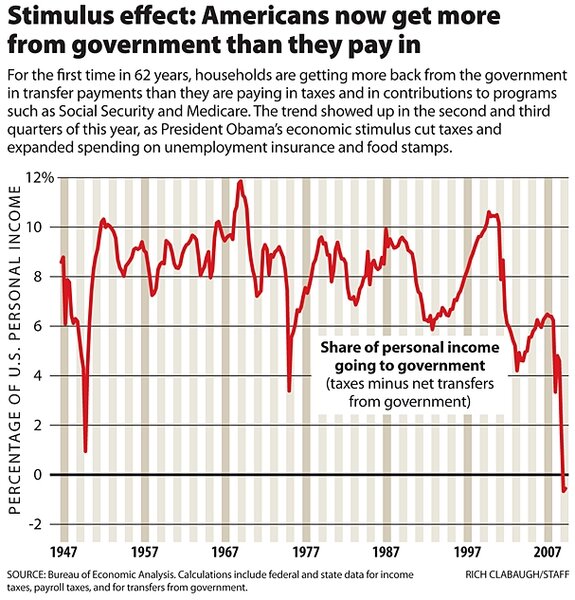Post-Depression first: Americans get more money from government than they give back
Loading...
For the first time since the 1930s, personal taxes paid by Americans aren't enough to cover the payments that the government sends out through transfer programs like Social Security and food stamps.
The trend, visible in government data on personal incomes, reflects both a deep recession and government efforts to prop up the economy.
A sagging economy has dragged down America's total personal income, causing tax revenues to plunge. It also has added to the ranks of people who qualify for unemployment insurance and other safety-net programs. That's not an unusual pattern during recessions, but the impact has been deeper this time.
In addition, the $787 billion economic stimulus program, launched earlier this year, has given Americans new tax cuts and expanded transfer programs.
The result: In the second quarter of 2009, Americans were getting $79.8 billion more in transfers than they were paying to government, on an annualized basis. That's about $260 per US resident. The amount was similar (a bit smaller) in the third quarter.
This recession-related pattern is an amplification of a larger trend that Americans are very familiar with: federal budget deficits. For years, tax revenues haven't covered all government spending. But usually households pay enough in taxes (income taxes and payroll taxes dedicated to Social Security and Medicare) to at least cover what's paid back to households in transfer programs.
Usually, a substantial sum is left over to pay for some of the government's other spending.
Not lately.
"We’ve actually seen payroll tax receipts decline at the federal level," says Gus Faucher, a senior economist at Moody's Economy.com in West Chester, Pa. "That's really quite unprecedented."
The stimulus programs are having a big impact on the flow of money between households and government, he says. For example, Social Security recipients got a one-time payment of $250, which showed up in the second quarter. And the stimulus included President Obama's "make work pay" tax cut, which gave millions of workers an extra $400 in spending money.
But an equally big factor, Mr. Faucher says, may be what economists call the economy's "automatic stabilizers" that are built into fiscal policy. This includes the tendency that people will owe smaller tax payments when the economy is in the doldrums than when it is booming. (They have smaller bonuses and lower capital gains from investments.) Safety-net programs, moreover, predictably kick into higher gear in recession. Spending on unemployment insurance was soaring even before Congress voted on the stimulus, with its extended jobless benefits.
How long will households be receiving more from government than they're paying in? It depends how the economy performs.
In the third quarter, gross domestic product went up. If that continues, it should help to push incomes up. That, in turn, should help tax revenues revive. Rising incomes should also help the private sector create jobs, easing the burden on government welfare programs.
In the much more severe economic conditions of the 1930s, the economy saw at least six straight years in which net government transfers exceeded tax receipts. This time, it may be just a few quarters.
"It doesn’t necessarily have to hurt the [federal] budget picture in the long run," Faucher says. The government's real fiscal problem, he says, is that budgets aren't even balancing during good years for the economy.
The numbers used in this story come from the Bureau of Economic Analysis, which publishes data on personal income, taxes, and transfer payments.
In the second and third quarters, Americans were paying taxes at an annual rate of about $2 trillion a year.
That includes state and federal income taxes, and it includes the payroll taxes paid by workers directly or indirectly (through employer contributions). The tax revenues were down significantly from a year before, when they were running at an annual pace above $2.3 trillion.
Meanwhile, transfer payments from the government to individuals have gone from less than $2 trillion in 2008 to more than $2 trillion this year. These include social insurance programs such as Medicare and also safety-net programs for the poor and unemployed – such as jobless benefits and food stamps.
The accompanying chart shows the 62 years for which quarterly data are available.
The line showing tax payments minus net transfers to individuals dips below zero this year because Americans are paying less than 9 percent of their income in taxes (usually it's 10 to 12 percent) and because net transfer payments have jumped to more than 9 percent of income.
-----
Follow us on Twitter.





